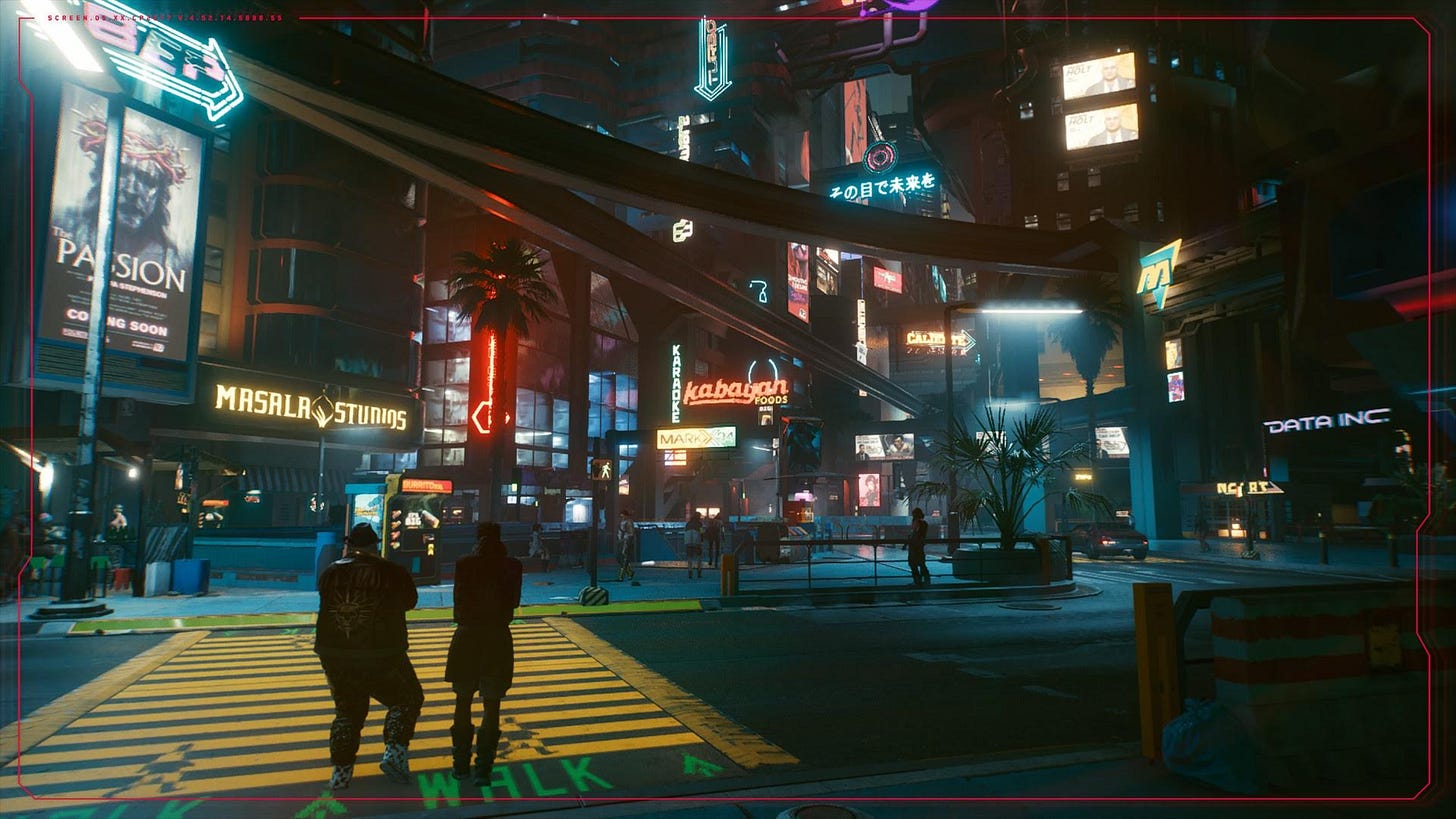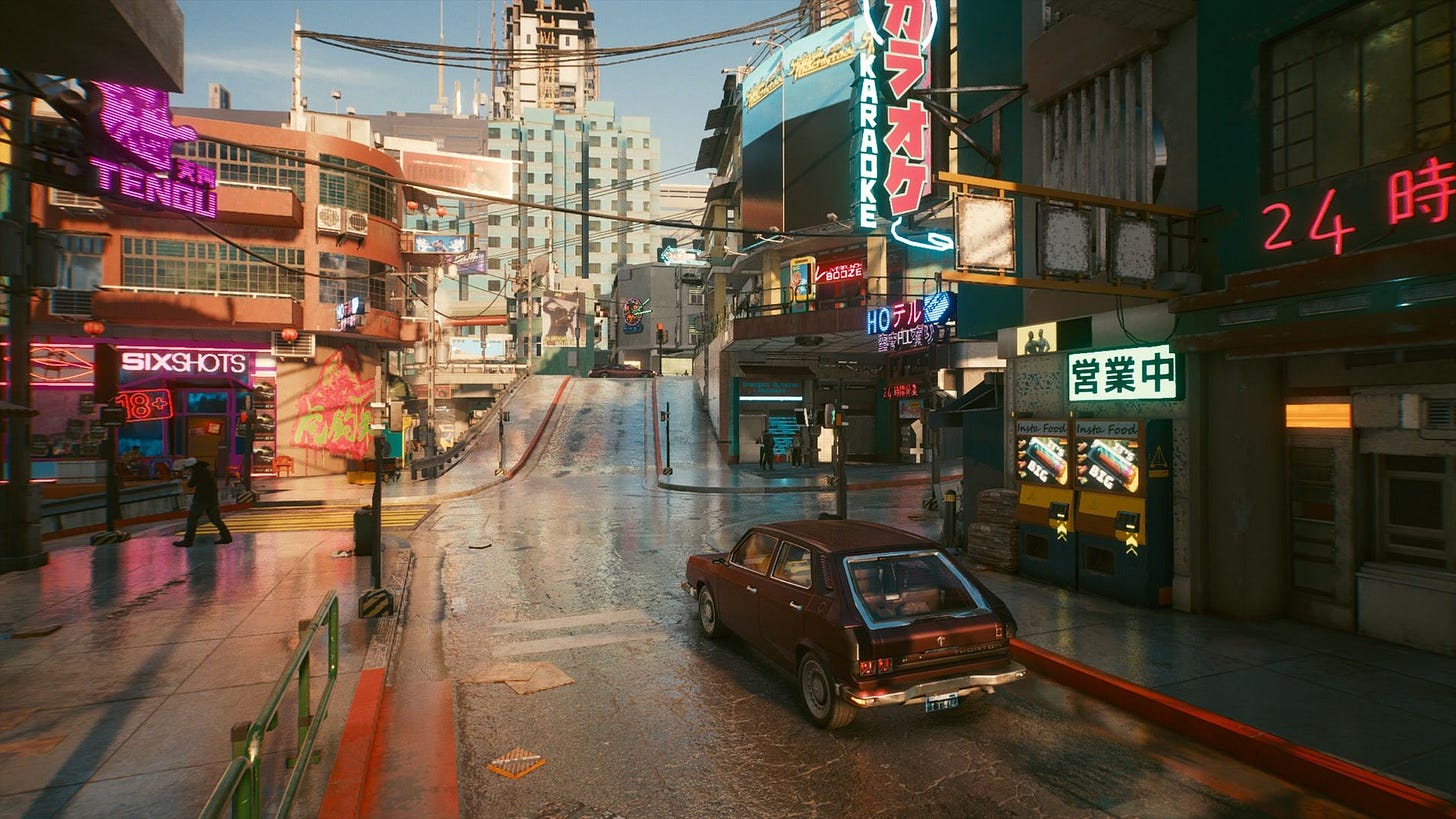Night City Is Every Place I Miss Right Now
It's far from tourist-friendly, but Cyberpunk 2077 is how I travel to my favorite places these days.
When I first stepped out of V’s apartment building in Cyberpunk 2077, I was reminded of a friend’s reaction to an Instagram Story from my visit to the UAE two years ago.
“Everything I’ve seen from your trip makes you feel so small,” she commented on my picture of the webbed dome arching above The Louvre in Abu Dhabi. I shared her sentiment easily, later realizing how accurately it described my feelings for Dubai’s fixation with colossal spectacles, from towering Burj Khalifa to the peninsula’s expansive southern desert, whose Arabic name aptly translates to The Empty Quarter.
As I took in my immediate surroundings in fictional Night City, I felt very small indeed. Behind me stood Megabuilding H10, an obscenely huge block of concrete that reminded me of the condominium clusters in Hong Kong. Across the street, a panoply of digital and LED billboards screamed ad after ad to my face that would put Shibuya to shame. A couple of blocks in a direction I couldn’t even tell you to save my life, a disorderly grid of street peddlers beckoned to me like the night market vendors I loved perusing in Taipei. Everywhere I looked, neon signs crackled brightly in the shadow of elevated highways that made me think of the tangled interchange in Makati that I used to make my way under on the way to the office.
Through its sheer density, architectural bloat, and melting pot of cultural influences, Night City manages to be every place I’ve been to all at once. Its effect on me has been a mix of vertigo and euphoria—the very same chemical reactions I have when visiting a new and foreign destination like Seoul or Bangkok. In the story told by Cyberpunk 2077, I’m a mercenary on a mission to save my identity from obliteration in a city buckling under the weight of social inequality. Outside this quest, I’m just your average tourist with a cybernetic hand, enjoying a pastiche of all the cities I wish I could visit in real life.
Without an active quest marker pointing you in the right direction, Night City is extremely disorienting during the first five hours. Everything around you begs to be observed in these opening moments while you’re still trying to comprehend the rules that govern this simulacrum of life. If you’re like me, you’re picking up every object that isn’t bolted to the ground, reading every journal entry that pops up on the side of the screen, or eavesdropping on random NPC’s on the street as they moan about the injustices of living under the chrome thumb of hyper-capitalist America.
The feeling isn’t unlike the first day of any trip in a foreign country. I remember my first visit to Osaka with my boyfriend, where some of our most surprising discoveries happened whenever we took small side roads on our way to a tourist spot on our itinerary. We’d find small schoolyards full of rosy-cheeked kids bundled in their winter clothing, inspect (and actually buy from) a vending machine installed on a random street corner, or spot a fully laden orange tree jutting just out of arm’s reach from behind a walled residence.
I’m reminded of these encounters whenever people romanticize travel as an act of “getting lost”. Never mind the itinerary or the walking directions blinking on your phone—in these moments of transit to a prescribed destination, no one expects you to do anything except to watch as the magic of ordinary, but unfamiliar life unfolds all around you.
Once I got over my intimidation of Night City’s chaos, I began a more nimble exploration of its locales. I would often go on foot, circling entire blocks while I picked off every point of interest marked on my map. Often, I’d turn a corner and find a scene that would remind me of the places I miss in real life. In the Little China district, you could mistake any of its streets for some narrow road connecting to Ongpin St. in Binondo, where we would go for savory pork chops or beef noodles after swimming at the local YMCA. The menacing skyscrapers lining Japantown’s avenues could easily be stand-ins for the Shanghai skyline, as could the colorful storefronts in Kabuki for the shopping alleys in Ximending. If I wasn’t observing a random food stall up close, I was looking up, admiring the staggering audacity of some of the building designs in this game.
My playstyle also benefits from this slow and curious observation of the environment. Mainly investing in V’s Intelligence and Cool attributes lets me use a stealth-hack approach to most missions: scope out the vicinity while crouched behind a low wall, run the Ping quickhack to locate every bad guy around me, and quietly take them down one by one.
Sneaking my way around levels has been my favorite way to get around open-world games. I did it as a sneak archer in Skyrim, piloting my drone from a safe spot in Watch Dogs, and while attempting a Low Chaos run in Dishonored. It beats just barging into some bad guy’s warehouse with guns blazing because you gain a more intimate connection to the world built by the game’s designers, where the reward is less about the eddies or the rare piece of gun you get and more about discovering cleverly placed workarounds in the environment—a ladder that takes you directly to your target, a forklift that opens up a new path, or simply preventing more dead bodies than necessary.
(That’s unless you’re roleplaying as a rampaging cyberpsycho with blades sticking out of your forearms, to which I say go ahead and butcher your way through the game as you please.)
Perhaps one thing I love more than “getting lost” in a city, whether in a game or in real life, is its complete opposite. When we visited Shanghai in 2017, there came a point when we realized that we’d mostly been circling this one massive public plaza called People’s Square while we were picking off each destination in our itinerary. We’d been using the subway to get around, which caused us to lose our sense of place within the city (not to mention the extra yuan we lost taking the train when we could have just walked). It became easier to orient ourselves shortly after, but more than that, I’d gained a deeper sense of my place in a city plied by millions of people everyday.
I experienced the same thing in Night City as I made my way to Viktor’s clinic not long after a campaign mission went south in the most spectacular manner. I was following the quest marker to his clinic when I realized that the ripperdoc was actually no less than a kilometer away from my apartment, and just a little further away was Lizzie’s Bar (where I hope to romance its hot bartender one day). All these places of interest were within walking distance, only I was too busy being carted off from one mission to the next during the prologue. In my mental map of Night City, the rest of the game’s locales snapped into place—even that random rooftop in Kabuki where I once squared off with a pair of twins who shared the same consciousness. I guess that’s the year 2077 for you.
The architecture of Cyberpunk 2077’s setting is oddly comforting to me. Within its bloated and incongruent design are intimate, familiar-looking spots that transport me to the real places I’m unable to see for now. I go around Night City, comparing snapshots of my favorite, albeit unavailable places with the virtual ones that I can afford to be in for now.
Here in my own apartment twenty floors above street level, I see and hear a city that I can’t be with. As I type away on my computer, I hear far below the clatter of the train I used to take to work everyday. From my balcony, I stare in the direction of Malate where our favorite coffee shop (thankfully) still operates. Come sunset, I’d watch the West Philippine Sea burn orange from my west-facing window, sometimes wondering when I can cross it again and visit the faraway cities that serve as my temporary reprieve from ordinary life.
For now, all I have is Night City and its imitation of the outside places that I love. Thirty hours later and it’s still fun being a tourist in this game—taking pictures of a Kabayan Foods eatery, visiting Jig-Jig Street after dark, getting into an argument with the local doomsayer about the death of free will and human dignity, and okay, maybe casually toppling evil corporations when I have the time.






